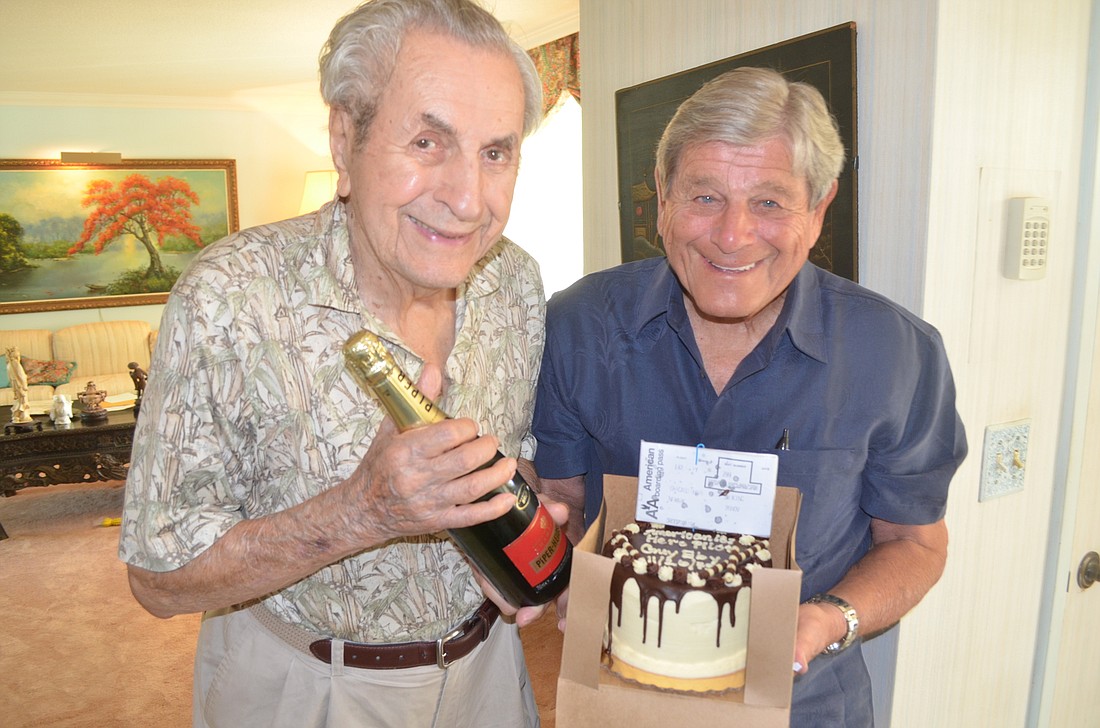- November 23, 2024
-
-
Loading

Loading

Burt Herman and Guy Eby didn’t meet until last week, but in 1975, they came close to dying together.
On Nov. 24, 1975, Eby was an airline pilot flying American Airlines Flight 182 from Chicago O’Hare International Airport to the airport in Newark, N.J., now known as Newark Liberty International Airport.
Air traffic controllers gave Eby clearance to climb to 37,000 feet over Michigan, but they made an error.
Suddenly, through the clouds, Eby saw the lights of a TWA L-1011 headed directly for American 182. Eby’s report of the incident estimates the aircraft were within 100 feet of each other.
“I still can’t believe that we came that close,” Herman said.
Herman, a Sarasota resident, was on the American DC-10 with his wife and three children on their way to Connecticut for a Thanksgiving reunion. He said he will never forget what happened next.
Eby dove the plane 2,000 feet in a matter of seconds, sending the rear cabin into chaos.
“It’s so otherworldly. We lost gravity momentarily, so people and things are flying above (in) the cabin,” Herman said. “When you see that, that’s indelible now. You can’t forget a scene like that.”
Herman remembers trying to grab his son, who was unbuckled, but couldn’t fight the force of the plane’s descent. When the plane suddenly leveled off, the passengers were left wondering what happened. Thirteen injuries were reported.
Despite his heroics, Eby did not offer passengers an explanation for the chaos.
“The plane (is) structurally sound,” Herman remembers Eby saying over the loudspeaker. “We’ll be making an emergency landing at Detroit Metropolitan Airport.”
Passengers had no idea how close they had come to catastrophe until the news media started reporting the following day a “near miss” between two commercial flights over Michigan.
“I didn’t want to tell the passengers,” Eby said. “I thought they’d be upset.”
For more than 41 years, Eby wondered if his silence was justified. Should he have told his passengers immediately the reason for his rapid descent?
On Feb. 9 in his home in Ormond Beach, Eby got an answer when Herman walked through his front door, arms extended to finally hug his hero.
Eby asked Herman if he thought he had made the right decision in not disclosing the near disaster.
“I think you did,” Herman told Eby. “It was so much to accept that carnage that was going on in the plane. If you would have told us how close we came, I think it would be too much for us to take in.”
Their meeting that day was the first time the pair had met face-to-face.
No other passengers on American 182 have reached out to Eby, but fate seems to favor Herman.
He made initial contact with Eby 15 years after the incident when Herman mentioned his near-death experience in a speech at an insurance conference in California.
“One person in the room knew the pilot,” Herman said.
He wrote Eby a letter thanking him for his split-second decision. Eby responded, but the pair weren’t able to meet at the time.
Their opportunity languished until three months ago, when Herman was preparing to give another presentation. While reviewing his remarks on the incident, the conference chairman offhandedly wondered if Eby was still alive.
Herman dismissed the comment as unlikely at first. Eby would be nearly 100, but then he thought again.
“Lady luck was his co-pilot in 1975, and I thought ‘I’m going to give it a try,’” Herman said.
A series of phone calls followed, and they made a plan to meet.
Their lives have been irrevocably affected by their brush with death. Eby, now 98, and Herman, 85, share piles of newspaper clippings documenting the incident. The headlines read “Plane Dives, Avoids Crash,” “Jets 20 Feet From Disaster,” and “Near Miss.”
Eby said that immediately after his desperate maneuver, he wondered if the other jet was real or if it had been an illusion.
But his piles of letters with their bent corners and yellowing pages serve as evidence that two jets on a collision course did, indeed, defy disaster.
In their initial correspondence in 1990, Eby told Herman he doesn’t know why their lives were spared.
“I sometimes think about my close encounters and wonder was the gift to continue life given to me or (was it) because someone on board ... was destined for a greater purpose in life,” Eby wrote.
As for Herman, he believes, at 85, he found his purpose for the life that was spared by a fraction of a second.
He wants to write a book about Eby and thinks it could be bound for Hollywood.
“He never brought attention to himself,” Herman said. “Somebody else had to be around to tell the story.”
Wayne Grant, news editor of the Ormond Beach Observer, contributed to this report.